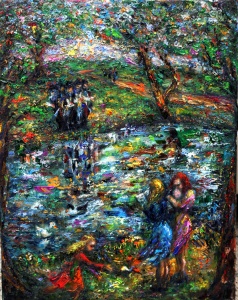Beyond Hasidic Expressionism
Passion of belief can certainly lead to passion of expression, especially for an artist. Rosa Katzenelson’s paintings and digital artwork currently at the Hadas Gallery in Brooklyn could easily define the very essence of religious expressionism. As a Chabad devotee, every aspect of her work exudes a passion for both the Chassidic subjects she depicts and for the visceral act of making a painting. Nonetheless, upon closer inspection her work yields considerably more complexity.

Dancing in the Rain presents an exuberant moment of religious consciousness in which the male dancer, kicking up his heels in the midst of a crowd on a wet sidewalk, seems almost suspended by the umbrella he holds aloft. The Chassidic crowd cheers him on, a swirl of black fedoras and dark umbrellas, while a blast of light in the upper right intimates that the rain is indeed a divine overflow. Quite the magical moment perhaps inspired by Gene Kelly’s Singing in the Rain (MGM 1952) film sequence in which the love-struck Kelly literally sings and dances on a rain-drenched Hollywood street. But then we notice the upside down figure in the foreground sidewalk. Immediately we assume it to be the dancing man’s reflection and yet it uncomfortably feels like something else. The head, hat and hand are too much in focus to be a mere reflection. So perhaps it is an allusion to a slain alter-ego, yetzer ha’ra, or dybbuk; whatever it may be, suddenly the first impression of carefree joy is tempered by more serious matters.

Light again operates as a mystical agent in Preparation from Below (Chatan l’Torah), flowing in from an open window to where a sefer Torah is about to be read. The open Torah, some of its letters magically floating over the klaf, is surrounded by no less than six intense men in talisim. In the foreground a young woman is handing a golden-haired child to a man while his older son stands alongside, thereby further defining the moment as the Kol haNe’arim, the blessing of all the children that introduces the aliyah of Chassan Torah. This painting breathes a joyful moment of expectation and celebration, depicting a blessing of light upon the moment that faithful Jews complete one year’s Torah cycle and prepare to take up the New Year’s Beraishis. The men and their children form a quivering white crown that surrounds the Torah, directly connected with the Divine light that illuminates its existence.

Katzenelson, who studied art and film in Argentina, also has a background as a clinical psychologist. This may give us some insight into the very recently completed Joseph’s Dance. At first glance we are at some kind of simcha with the central figure, presumably Joseph, dancing wildly with another foreground figure. Most of the onlookers seem engaged and cheery although two on the extreme right exude a barely concealed animosity. Count them all up and there are ten and then of course we understand that this contemporary scene is actually depicting the biblical Joseph. Now the mad enthusiasm starts to come into focus with each brother reflecting his relationship with the troublesome Joseph. We wonder exactly where in the narrative has the artist located this scene. If it is before the outbreak of their conflict then the shiny new blue-black suit Joseph wears fits perfectly as the “coat” Jacob gives him, as does his flying peyoes and maniacal expression. This is the young reckless Joseph, not careful with his words or actions around his older brothers. Or perhaps we are seeing a homecoming, the chastened brothers readmitting Joseph into the family fold, with the lingering resentment and fear of at least two of them on the side. Then this is Joseph triumphant, still unnervingly sure of himself, dominant and even a bit dangerous. Whichever scene we choose, the artist has collapsed the long convoluted narrative of Joseph and his brothers into one insightful moment of familial complexity and tension.

Mystery is at the heart of every good painting. To be otherwise renders art into illustration and The Eye of the Fish is no exception. Set around a bucolic pond we slowly make out four or five male figures tightly clustered on the far side of the pond, each holding what may be a prayer book. Immediately tashlich comes to mind. But what of the two beautifully painted ladies in the foreground? They too have a prayer book, but it seems one is holding an infant even as a young girl playfully runs alongside them. Men on one side, women on the other, a shimmering pond between them in fading hours of Rosh HaShanah. This artwork, in its lush brushwork, evocative setting and characters is a beautiful pastoral that contemplates the complexity and quiet delights of a year about to unfold. The image is evocative, charming, playful and yet wonderfully serious about the joys of living in a Jewish world. Out of Rosa Katzenelson’s passion for Yiddishkeit and making art comes flashes of insights and mystery that make returning to the paintings over and over a pure delight.
Hadas Gallery (hadasgallery.com)
541 Myrtle Avenue, Brooklyn, New York
[email protected]